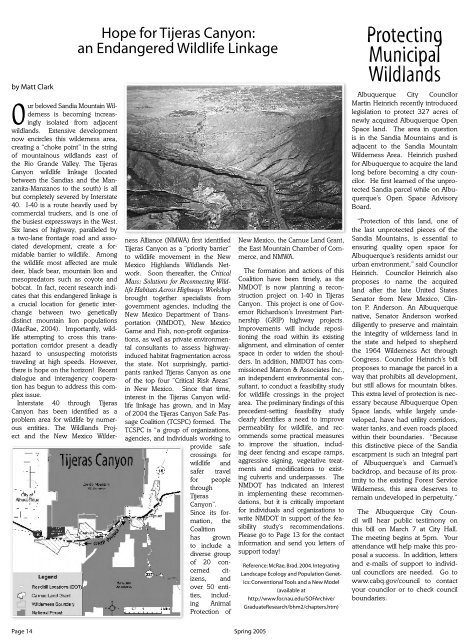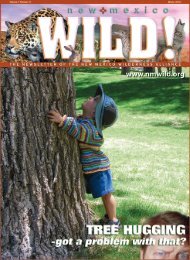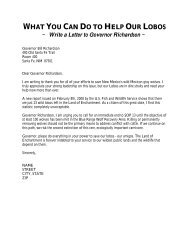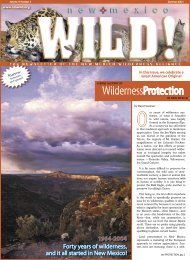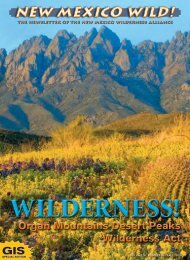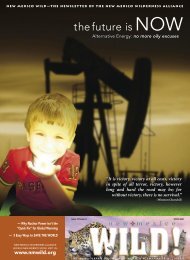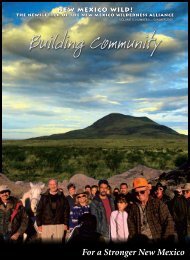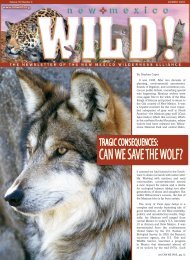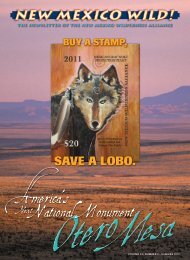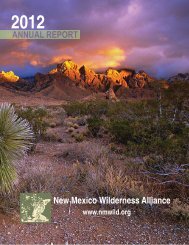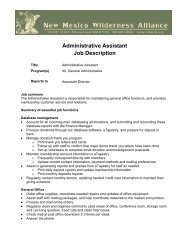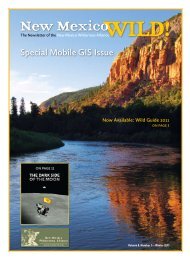FIGHTING THE GOOD FIGHT - New Mexico Wilderness Alliance
FIGHTING THE GOOD FIGHT - New Mexico Wilderness Alliance
FIGHTING THE GOOD FIGHT - New Mexico Wilderness Alliance
Create successful ePaper yourself
Turn your PDF publications into a flip-book with our unique Google optimized e-Paper software.
y Matt Clark<br />
Hope for Tijeras Canyon:<br />
an Endangered Wildlife Linkage<br />
Our beloved Sandia Mountain <strong>Wilderness</strong><br />
is becoming increasingly<br />
isolated from adjacent<br />
wildlands. Extensive development<br />
now encircles this wilderness area,<br />
creating a “choke point” in the string<br />
of mountainous wildlands east of<br />
the Rio Grande Valley. The Tijeras<br />
Canyon wildlife linkage (located<br />
between the Sandias and the Manzanita-Manzanos<br />
to the south) is all<br />
but completely severed by Interstate<br />
40. I-40 is a route heavily used by<br />
commercial truckers, and is one of<br />
the busiest expressways in the West.<br />
Six lanes of highway, paralleled by<br />
a two-lane frontage road and associated<br />
development, create a formidable<br />
barrier to wildlife. Among<br />
the wildlife most affected are mule<br />
deer, black bear, mountain lion and<br />
mesopredators such as coyote and<br />
bobcat. In fact, recent research indicates<br />
that this endangered linkage is<br />
a crucial location for genetic interchange<br />
between two genetically<br />
distinct mountain lion populations<br />
(MacRae, 2004). Importantly, wildlife<br />
attempting to cross this transportation<br />
corridor present a deadly<br />
hazard to unsuspecting motorists<br />
traveling at high speeds. However,<br />
there is hope on the horizon! Recent<br />
dialogue and interagency cooperation<br />
has begun to address this complex<br />
issue.<br />
Interstate 40 through Tijeras<br />
Canyon has been identifi ed as a<br />
problem area for wildlife by numerous<br />
entities. The Wildlands Project<br />
and the <strong>New</strong> <strong>Mexico</strong> <strong>Wilderness</strong><br />
<strong>Alliance</strong> (NMWA) fi rst identifi ed<br />
Tijeras Canyon as a “priority barrier”<br />
to wildlife movement in the <strong>New</strong><br />
<strong>Mexico</strong> Highlands Wildlands Network.<br />
Soon thereafter, the Critical<br />
Mass: Solutions for Reconnecting Wildlife<br />
Habitats Across Highways Workshop<br />
brought together specialists from<br />
government agencies, including the<br />
<strong>New</strong> <strong>Mexico</strong> Department of Transportation<br />
(NMDOT), <strong>New</strong> <strong>Mexico</strong><br />
Game and Fish, non-profi t organizations,<br />
as well as private environmental<br />
consultants to assess highwayinduced<br />
habitat fragmentation across<br />
the state. Not surprisingly, participants<br />
ranked Tijeras Canyon as one<br />
of the top four “Critical Risk Areas”<br />
in <strong>New</strong> <strong>Mexico</strong>. Since that time,<br />
interest in the Tijeras Canyon wildlife<br />
linkage has grown, and in May<br />
of 2004 the Tijeras Canyon Safe Passage<br />
Coalition (TCSPC) formed. The<br />
TCSPC is “a group of organizations,<br />
agencies, and individuals working to<br />
provide safe<br />
crossings for<br />
wildlife and<br />
safer travel<br />
for people<br />
through<br />
Tijeras<br />
Canyon”.<br />
Since its formation,<br />
the<br />
Coalition<br />
has grown<br />
to include a<br />
diverse group<br />
of 20 concerned<br />
citizens,<br />
and<br />
over 50 entities,<br />
including<br />
Animal<br />
Protection of<br />
<strong>New</strong> <strong>Mexico</strong>, the Carnue Land Grant,<br />
the East Mountain Chamber of Commerce,<br />
and NMWA.<br />
The formation and actions of this<br />
Coalition have been timely, as the<br />
NMDOT is now planning a reconstruction<br />
project on I-40 in Tijeras<br />
Canyon. This project is one of Governor<br />
Richardson’s Investment Partnership<br />
(GRIP) highway projects.<br />
Improvements will include repositioning<br />
the road within its existing<br />
alignment, and elimination of center<br />
space in order to widen the shoulders.<br />
In addition, NMDOT has commissioned<br />
Marron & Associates Inc.,<br />
an independent environmental consultant,<br />
to conduct a feasibility study<br />
for wildlife crossings in the project<br />
area. The preliminary fi ndings of this<br />
precedent-setting feasibility study<br />
clearly identifi es a need to improve<br />
permeability for wildlife, and recommends<br />
some practical measures<br />
to improve the situation, including<br />
deer fencing and escape ramps,<br />
aggressive signing, vegetative treatments<br />
and modifi cations to existing<br />
culverts and underpasses. The<br />
NMDOT has indicated an interest<br />
in implementing these recommendations,<br />
but it is critically important<br />
for individuals and organizations to<br />
write NMDOT in support of the feasibility<br />
study’s recommendations.<br />
Please go to Page 13 for the contact<br />
information and send you letters of<br />
support today!<br />
Reference: McRae, Brad. 2004. Integrating<br />
Landscape Ecology and Population Genetics:<br />
Conventional Tools and a <strong>New</strong> Model<br />
(available at<br />
http://www.for.nau.edu/SOFArchive/<br />
GraduateResearch/bhm2/chapters.htm)<br />
Protecting<br />
Municipal<br />
Wildlands<br />
Albuquerque City Councilor<br />
Martin Heinrich recently introduced<br />
legislation to protect 327 acres of<br />
newly acquired Albuquerque Open<br />
Space land. The area in question<br />
is in the Sandia Mountains and is<br />
adjacent to the Sandia Mountain<br />
<strong>Wilderness</strong> Area. Heinrich pushed<br />
for Albuquerque to acquire the land<br />
long before becoming a city councilor.<br />
He fi rst learned of the unprotected<br />
Sandia parcel while on Albuquerque’s<br />
Open Space Advisory<br />
Board.<br />
“Protection of this land, one of<br />
the last unprotected pieces of the<br />
Sandia Mountains, is essential to<br />
ensuring quality open space for<br />
Albuquerque’s residents amidst our<br />
urban environment,” said Councilor<br />
Heinrich. Councilor Heinrich also<br />
proposes to name the acquired<br />
land after the late United States<br />
Senator from <strong>New</strong> <strong>Mexico</strong>, Clinton<br />
P. Anderson. An Albuquerque<br />
native, Senator Anderson worked<br />
diligently to preserve and maintain<br />
the integrity of wilderness land in<br />
the state and helped to shepherd<br />
the 1964 <strong>Wilderness</strong> Act through<br />
Congress. Councilor Heinrich’s bill<br />
proposes to manage the parcel in a<br />
way that prohibits all development,<br />
but still allows for mountain bikes.<br />
This extra level of protection is necessary<br />
because Albuquerque Open<br />
Space lands, while largely undeveloped,<br />
have had utility corridors,<br />
water tanks, and even roads placed<br />
within their boundaries. “Because<br />
this distinctive piece of the Sandia<br />
escarpment is such an integral part<br />
of Albuquerque’s and Carnuel’s<br />
backdrop, and because of its proximity<br />
to the existing Forest Service<br />
<strong>Wilderness</strong>, this area deserves to<br />
remain undeveloped in perpetuity.”<br />
The Albuquerque City Council<br />
will hear public testimony on<br />
this bill on March 7 at City Hall.<br />
The meeting begins at 5pm. Your<br />
attendance will help make this proposal<br />
a success. In addition, letters<br />
and e-mails of support to individual<br />
councilors are needed. Go to<br />
www.cabq.gov/council to contact<br />
your councilor or to check council<br />
boundaries.<br />
Page 14 Spring 2005


